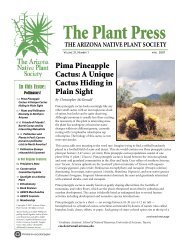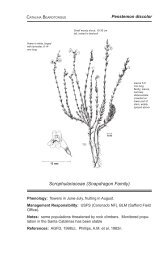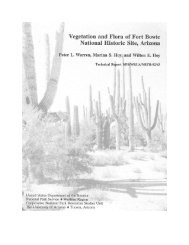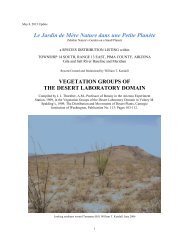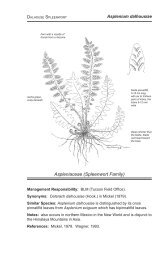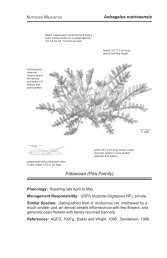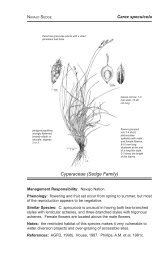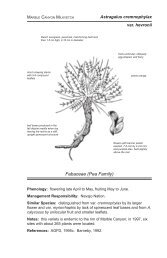T14S.R13E Pima County.AZ 050813 - Arizona Native Plant Society
T14S.R13E Pima County.AZ 050813 - Arizona Native Plant Society
T14S.R13E Pima County.AZ 050813 - Arizona Native Plant Society
Create successful ePaper yourself
Turn your PDF publications into a flip-book with our unique Google optimized e-Paper software.
presentation), 77, 85 (102211 - color presentation), 89 (reported as being a perennial herb located on Tumamoc Hill, possiblyrecorded as Bouteloua bromoides (H.B.K.) Lag.), 105 (recorded as Bouteloua filiformis (Fourn.) Griffiths), 124 (102510 - norecord of species; genus record), 140 (Page 299)*Bouteloua repens var. repens (see footnote 85 under Bouteloua repens)Bouteloua rothrockii G. Vasey: Rothrock’s GramaSYNONYMY: Bouteloua barbata M. Lagasca y Segura var. rothrockii (G. Vasey) F.W. Gould. COMMON NAMES:Navajita Liebrero (Spanish); Rothrock Grama; Rothrock’s Grama. DESCRIPTION: Terrestrial perennial tufted graminoid (abunchgrass (clumpgrass) with decumbent, geniculate, ascending and/or erect culms 8 to 30 inches in height); the foliage is greencuring to straw; the flowers may be brownish-red, pale green, green, orange or reddish; the anthers are pink or white; floweringgenerally takes place between late July and late September (additional records: one for early March, one for mid-May, one forlate May, one for late October and one for mid-November). HABITAT: Within the range of this species it has been reportedfrom mountains; rocky-gravelly mountainsides; gravelly and sandy mesas; along canyons; sandy canyon bottoms; rocky androcky-gravelly and gravelly-loamy foothills; rocky and rocky-sandy hills; rocky, gravelly and gravelly-sandy-loamy hillsides;rocky, rocky-gravelly, gravelly, sandy, sandy-loamy, sandy-clayey and clayey slopes; rocky alluvial fans; gravelly and sandybajadas; prairies; along rocky, cobbly and sandy plains; bouldery-sandy, gravelly, gravelly-loamy and sandy flats; basins;gravelly-loamy valley floors; valley bottoms; along gravelly and sandy roadsides; sandy draws; sandy bottoms of gulches;streambeds; sandy riverbeds; along washes; rocky drainages; within drainages; swales; edges of washes; along margins ofciénegas; benches; terraces; sandy floodplains; mesquite bosques; riparian areas, and disturbed areas growing in dry boulderysandy,rocky, rocky-gravelly, rocky-sandy, cobbly, gravelly and sandy ground; rocky-clayey loam, gravelly loam, gravelly-sandyloam, gravelly-clayey loam, sandy loam and sandy-clayey loam ground, and sandy clay and clay ground, occurring from 300 to5,700 feet in elevation in the forest, woodland, scrub, grassland, desertscrub and wetland ecological formations. NOTES: Thisshort-lived perennial may be an attractive component of a restored native habitat, it has been described as being hardy anddrought-resistant. Rothrock Grama (perennial) may be confused with the annual Sixweeks Grama (Bouteloua barbata). theMasked Bobwhite (Colinus virginianus subsp. ridgwayi) feeds on the seeds of the Rothrock Grama. Bouteloua rothrockii isnative to southwest-central and southern North America. *5, 6, 15, 16 (recorded as Bouteloua barbata Lag. var. rothrockii(Vasey) Gould), 33 (Page 151), 43 (093009), 44 (112210 - no record of species; genus record), 46 (Page 128), 48, 56, 57, 58, 63(093009 - color presentation), 77, 85 (102211 - color presentation of dried material), 89 (reported as being a perennial herblocated on the Mesa-like Mountain Slopes), 105, 124 (102510 - no record of species; genus record), 140 (Page 200 & 299 -recorded as Bouteloua barbata Lagasca var. rothrockii (Vasey) Gould)*Bouteloua trifida G. Thurber (var. trifida is the variety reported as occurring in <strong>Arizona</strong>): Red GramaCOMMON NAMES: China; Navajita (“Little Knife” a name also applied to other species, Spanish); Navajita China(Spanish); Navajita Roja (Spanish); Red Grama (a name also applied to other species); Red Grama Grass; Red Gramagrass; RedGramma; Red Gramma Grass; Three-awn Grama; Three-awned Grama; Threeawn Grama; Threeawn-grama; Trifid Grama.DESCRIPTION: Terrestrial perennial tufted graminoid (decumbent, slighty geniculate, ascending and/or erect culms 2 to 16inches in height); the foliage may be purple; the spikelets (flowers) are reddish-purple; the anthers are yellow; floweringgenerally takes place between mid-March and late May (additional records: one for early August, two for mid-August, one forearly September, one for late September and two for late October). HABITAT: Within the range of this species it has beenreported from rocky mountains; mesas; rocky cliffs; rocky canyons; along canyon walls; gorges; talus slopes; crevices in rocks;pockets of soil in bedrock; bluffs; rocky ledges; bouldery ridges; ridgetops; foothills; bouldery, rocky, rocky-gravelly, stonygravellyand loamy hills; bouldery and rocky hillsides; bouldery-rocky, rocky, gravelly, sandy and sandy-loamy slopes; bajadas;rocky outcrops; dunes; clayey prairies; plains; gravelly flats; basins; valley floors; roadbeds; along rocky, gravelly-sandy andclayey roadsides; sandy arroyos; gulches; springs; along streams; along and in bedrock, cobbly-gravelly-sandy and gravellysandywashes; within rocky drainages; within drainage ways; around pools; depressions; (rocky) banks of arroyos; floodplains;ditches, and riparian areas growing in dry bouldery, bouldery-rocky, rocky, rocky-cobbly-gravelly-sandy, rocky-gravelly, stony,stony-gravelly, cobbly-gravelly-sandy, gravelly, gravelly-sandy and sandy ground; sandy loam ground, and clay ground,occurring from 700 to 8,200 feet in elevation in the grassland, desertscrub and wetland ecological formations. NOTES: Thisplant may be an attractive component of a restored native habitat, it is reported to be drought-resistant; it may form patches orrings, and it is sometimes mistaken for an Aristida spp. because of the three-awned spikelets. Bouteloua trifida is native tosouthwest-central and southern North America. *5, 6, 15, 16, 33 (Page 151), 43 (100109), 44 (021911), 46 (Page 128), 63(102311), 77, 85 (102311 - color presentation including habitat), 89 (reported as being a perennial herb located on the Mesa-likeMountain Slopes), 124 (021911 - no record of species; genus record)*Brachiaria arizonica (see Urochloa arizonica)Brachiaria fasciculata (see Urochloa fusca)Bromus arizonicus (C.L. Shear) G.L. Stebbins: <strong>Arizona</strong> BromeSYNONYMY: Bromus carinatus W.J. Hooker & G.W. Arnott var. arizonicus C.L. Shear. COMMON NAMES:<strong>Arizona</strong> Brome (a name also applied to other species); <strong>Arizona</strong> Brome Grass; <strong>Arizona</strong> Chess. DESCRIPTION: Terrestrial annual38



